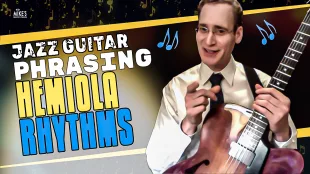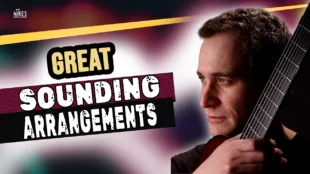Jazz guitar is a demanding and complex art form that requires years of dedicated practice to master. To become a great jazz guitarist, you need to develop a strong technical foundation, a deep understanding of music theory, and the ability to improvise and perform at a high level. In this article, we’ll explore six methods for jazz guitarists to improve their performance capabilities and take their playing to the next level.
It All Starts with Rhythm
Music consists of three elements: melody, harmony, and rhythm. Of those three, rhythm is the element generally accepted to be the most fundamental and important. Unfortunately, rhythm is also the element that the majority of developing jazz guitarists (and most other instrumentalists) explore the least. Many guitarists have spent years honing the craft of melodic and chordal playing but still have that elusive something missing: the glue that holds everything together as a compelling, coherent musical statement. For many of these players, that missing factor is rhythm.
Timing is everything in jazz, and practicing with a metronome is one of the best ways to develop a solid sense of time. By practicing with a metronome, you can improve your timing accuracy, develop your internal clock, and gain the ability to play in time with other musicians.
To get the most out of your metronome practice, start by practicing simple exercises and gradually increase the tempo as you become more comfortable. Focus on playing with a steady, consistent beat, and pay close attention to any fluctuations in your timing. Over time, you’ll develop a rock-solid sense of time that will greatly improve your performance capabilities.
Recommended Timing Courses
Intermediate Study of Jazz Standards
Jazz standards are the backbone of the jazz repertoire, and studying them is essential for any jazz guitarist. By studying jazz standards, you can develop your improvisational skills, learn new chord progressions and melodic ideas, and gain a deeper understanding of the jazz language.
To get started with jazz standards, choose a few tunes that you love and start learning the chords and melody. Practice improvising over the changes, experimenting with different scales and arpeggios. As you become more comfortable with the tunes, you can start adding your own personal touch and developing your own improvisational style.
Jazz Standards for the Intermediate Jazz Guitarist
Practical Scales and Arpeggio Ideas
Scales and arpeggios are the building blocks of jazz guitar, and practicing them is essential for developing your technical skills. By practicing scales and arpeggios, you can improve your finger dexterity, develop your fretboard knowledge, and gain the ability to play fast and fluid lines.
To get the most out of your scale and arpeggio practice, start by learning the basic fingerings for all the major and minor scales, as well as the basic arpeggio shapes for all the chord types. Practice them in all keys, starting slowly and gradually increasing the tempo as you become more comfortable.
Scales and Arpeggio Courses
Transcribe and Analyze Solos
Transcribing and analyzing solos is one of the most effective ways to develop your improvisational skills and gain a deeper understanding of jazz language. By transcribing solos, you can learn new melodic ideas, develop your ear training, and gain the ability to play in the style of your favorite jazz musicians.
To transcribe a solo, choose a recording that you love and listen to it carefully, taking note of the melody, chord changes, and rhythm. Try to play along with the recording, using your ear to figure out the notes and rhythms. Once you’ve transcribed the solo, analyze it, looking for patterns and ideas that you can incorporate into your own playing.
Intermediate Soloing Courses
Work on Chord Melody Arrangements
Chord melody arrangements are a hallmark of jazz guitar, and mastering them is essential for any jazz guitarist. By working on chord melody arrangements, you can develop your chord knowledge, improve your fingerstyle technique, and gain the ability to play complex arrangements that combine melody, harmony, and rhythm.
To get started with chord melody arrangements, choose a jazz standard that you love and start working on a simple arrangement. Practice playing the melody and chords together, experimenting with different voicings and fingerings. As you become more comfortable, you can start adding embellishments and variations to make the arrangement your own.
Chord Melody Courses to Push Your Level
Improving your performance capabilities as a jazz guitarist requires a combination of technical skills, music theory knowledge, and improvisational abilities. By working on rhythm, studying jazz standards, practicing scales and arpeggios, transcribing solos, working on chord melody arrangements, and playing with other musicians, you can develop a well-rounded set of skills that will take your jazz guitar playing to the next level.


















